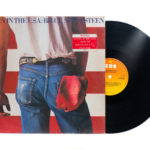by Clay Mills
May 21, 2024

In storytelling, there is a principle called “The Rule of Three.” This principle points to the tendency for plays, movies, and stories to have three repeating or related elements. Stories and plays usually have three acts. In fairy tales, the hero is often granted three wishes. In the story, “The Three Little Pigs,” the big bad wolf visits three different pigs’ houses. I believe it’s true, we tend to receive and retain stories better with a beginning, middle, and end.
The power of three goes well beyond storytelling: the Biblical Holy Trinity, Three Ringed Circus, three primary colors.
The list goes on and on and on, because there’s something about groupings of three that appeal to the human mind. And so, too, the power of three hooks the ear in music.
A few examples of the musical power of three include song titles from Bruce Springsteen’s Born In The USA album.

Half of the songs on this iconic rock album employ three-syllable titles:
“Cover Me”
“Downbound Train”
“Bobby Jean”
“Glory Days”
“My Hometown”
Springsteen clearly taps into the power of 3 in his songs. His success speaks for itself.
Line+3
I’ve made it a life-long obsession to search for timeless melodic devices—techniques that work in every genre, in any decade of music. And I’ve made good use of these discoveries over my career to write genre-crossing hits. If you ask me to choose one device that hooks the listener more than any other, it would be Line+3. This is part of a complete system I teach in my masterclasses called: Line+.
Line+3 is a song pattern using rhythm, rhyme, and melodic repetition to make songs better.
To understand exactly what Line+3 is, let’s look at an excerpt from my book Mastering Melody Writing that highlights several decades of music…
Listen to the finale from Tchaikovsky’s “1812 Overture.” (The one with the cannons.) If you still don’t know how this music goes, find it and listen, please!
Da-da-da-da-da-da-da . . . dum, dum, dum
Do you see it (and hear it)? Three beats clumped together at the end of a line of 16th notes and repeated:
Da-da-da-da-da-da-da . . . dum, dum, dum
Da-da-da-da-da-da-da . . . 1, 2, 3
Even when it changes notes, it repeats the same rhythmic pattern:
Da-da-da-da-da-da-da . . . dum, dum, dum
Da-da-da-da-da-da-da . . . dum, dum, dum
The Beatles’ song “Yesterday,” the most covered song of all time, has a number of three-note accented rhyming sections:
Yesterday
All my troubles seemed so… far–a–way
Now it looks as though they’re…here–to–stay
Oh, I believe in…Yes–ter–day
One of the best examples of Line+3 from the disco era is “Never Gonna Give You Up” with Rick Astley singing. It uses the classic tresillo, or triplet, feel at the end of the chorus vocal lines. And yes, you are about to be Rick-Rolled!
Never gonna… give–you–up
Never gonna…let–you–down
Never gonna…run–a–round
And desert you
Never gonna…make–you–cry
Never gonna…say–good–bye
Never gonna…tell–a–lie
And hurt you
I like to think of these types of melody patterns as two separate parts: the “Line” followed by the “3.”
Never gonna… give–you–up
Never gonna…let–you–down
Or…
Never gonna…1-2-3
Never gonna…1-2-3
Often, the three notes that end each line are syncopated, but they don’t have to be. The Tchaikovsky example had three “straight” accented notes at the tail of each line. It’s still equally hooky.
Now that you’re in on the Line+3 secret, I encourage you to experiment with this pattern in your own music.
Using the pattern and the power of three will help make your songs more memorable, and hopefully, leave your audiences humming your songs all day long. Make it a point to listen for this pattern whenever you hear music. You’ll find plenty of contemporary examples of Line+3 from country music’s Eric Church singing “‘Round Here Buzz” to pop sensation NF and his song “Let You Down.” Also keep in mind that hooky patterns are not just for choruses. Verses need hooks too!
If you want to learn more about other hooky Line+ combinations, check out Mastering Melody Writing: A Songwriter’s Guide to Hookier Songs With Pattern, Repetition, and Arc.
Until next time, work that melody and the power of three! Write on!
Clay
share
Write Better Songs Faster
Songwriting Success is Clay & Marty's 10-day video series that will help you level-up your songs and finish them faster. Enter your email address to get started!



